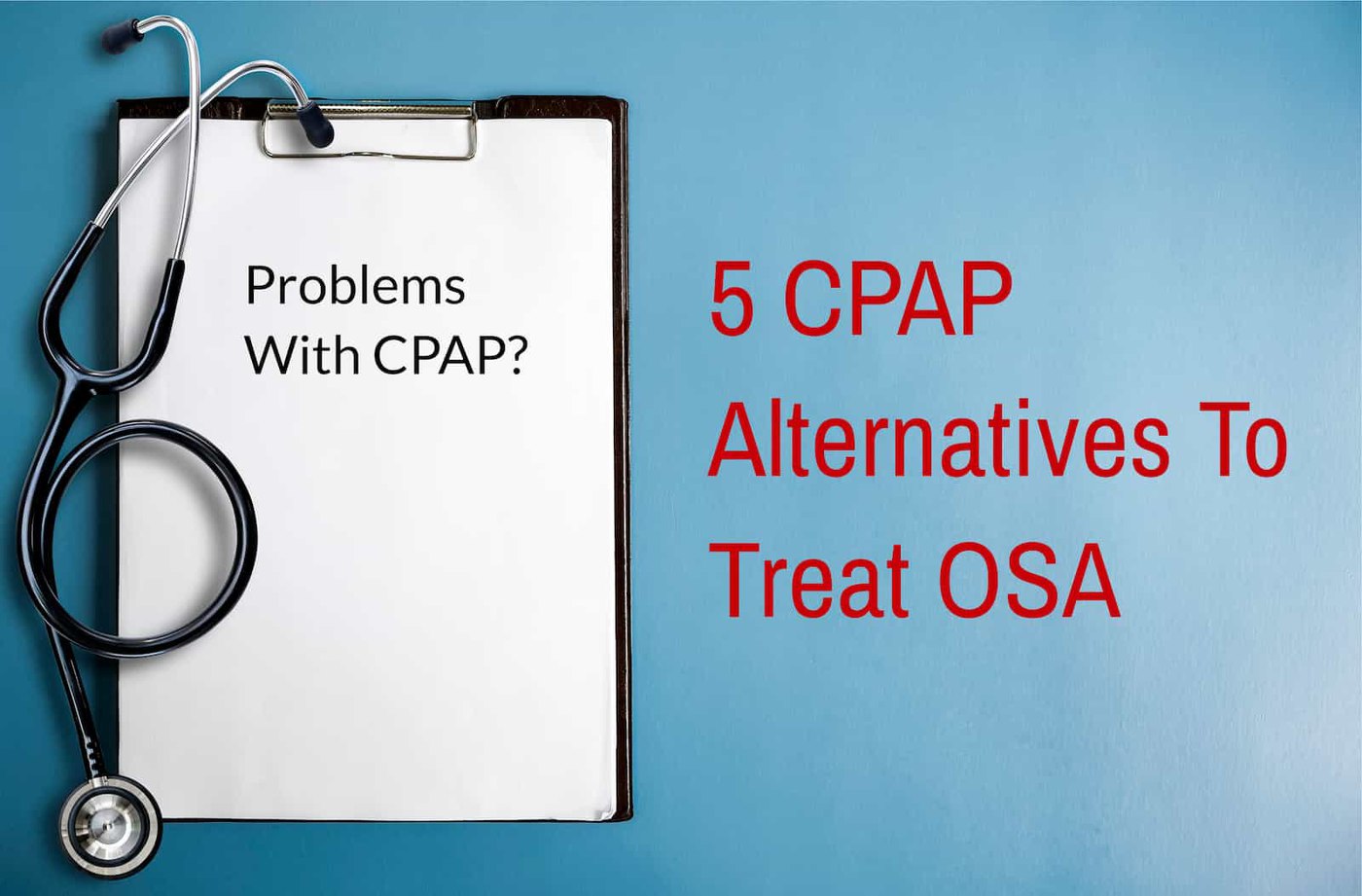Problems With CPAP? 5 CPAP Alternatives To Treat Obstructive Sleep Apnea (OSA)
May 12th, 2022 | 4 min. read


Sleep apnea is characterized by sporadic pauses in breathing as you sleep. It can leave you waking at night gasping for air or feeling overly exhausted the following day as a result of insufficient sleep.
Sleep apnea takes place in three common forms such as central sleep apnea, complex sleep apnea, and obstructive sleep apnea. Obstructive sleep apnea affects up to 9 percent of adults living with sleep apnea making it the most common type of sleep apnea, according to the Sleep Foundation.
The primary course of treatment for OSA is continuous positive airway pressure (CPAP). This machine forces pressurized air as you sleep to maintain an open airway. Though this is the preferred method of treatment for many providers, many people experience problems with CPAP use as it is quite uncomfortable and can disrupt sleep almost as much as obstructive sleep apnea itself.
The good news? There are CPAP alternatives available for treating obstructive sleep apnea.
Alternative Treatment for Obstructive Sleep Apnea
Obstructive sleep apnea affects millions of people each year, however, many people opt for alternative treatment options for various reasons, including cost, requirements, and side effects. It is important to discuss each option you are considering with your physician as they can help you to make a decision based on your personal medical history. That said, popular alternative treatment for OSA includes:
Inspire Sleep Apnea Treatment
Inspire sleep apnea treatment is conducted through a battery-operated, implantable device. This device is implanted into the patient’s chest through two small incisions where a breathing sensor lead, small generator, and a stimulation lead are placed. During bedtime, the patient can turn the device on where the machine can monitor breathing patterns and stimulate upper airway muscles as needed to keep the airway open.
Inspire therapy requires certain criteria to be met before a physician will consider you a viable candidate including:
- Moderate to severe OSA
- CPAP is contraindicated or not tolerated
- Your BMI is less than 35
- You are at least 18 years of age
It is important to discuss all risks versus benefits thoroughly with your physician before taking this treatment course to ensure it is right for you.
Interested in learning if the inspire sleep apnea device will work for you?
Watch this video. If interested in learning more click the link below to request an appointment today!
Dental Appliance for Sleep Apnea
When you think of a trip to the dentist's office, you often think of x-rays and thorough cleaning - but dentists also treat obstructive sleep apnea. Dental implants and oral appliances — like a mouthguard, help to position the teeth.
Mandibular advancement devices work by pulling the jaw forward while tongue positioning devices keep the tongue thrust forward reducing the risk of airway obstruction. The dental implant must be appropriately sized, allowing it to work as it was intended.
Most of these devices are made using non-toxic silicone or plastic. Some are made with a hinge allowing you to continually open your mouth while wearing the device. Mandibular advancement devices are more cost-effective than the traditional obstructive sleep apnea treatment through continuous positive airway pressure, but, they have the potential to lead to things like TMJ or shifting of the teeth.
Positional Therapy for OSA
Sleep specialists recommend sleeping supine, or flat on your back, as this position helps to maintain proper spinal alignment throughout the night. This helps to ease pain and pressure from improper sleep. Unfortunately, it can also increase the risk of upper airway obstruction for those living with obstructive sleep apnea.
While lying supine, the tongue is at an increased risk of falling to the back of the mouth. This can potentially block the upper airway and cause a temporary pause in breathing, which can be problematic if you have OSA.
If you're living with obstructive sleep apnea, it is recommended to sleep on your side, whichever side is more comfortable, and maintain minimal apneic episodes. A wedge pillow can be very helpful in maintaining a side sleeping position.
Weight Loss and OSA
People living with obesity or excessive weight gain experience more fat deposits throughout their body, especially around the neck. These additional fat deposits have the potential to lead to an upper airway blockage, making breathing increasingly difficult as you sleep.
Exercise and weight loss can reduce fat deposits throughout the body. More specifically, oropharyngeal exercises can minimize fat deposits in the neck and may eliminate obstructive sleep apnea symptoms.
Working alongside a personal trainer, dietician, and/or weight loss specialist can help you achieve your weight-loss goals more efficiently. They are there to provide an excellent, well-balanced meal plan, tell you what workouts to do, when to do them, and for how long, and help you maintain healthy weight-loss strategies.
One common oropharyngeal exercise that is used to keep the tongue from becoming increasingly floppy during the night is tongue stretches. To do this, stretch your tongue out as far as you can throughout the day, attempting to touch your chin. This exercise can be done anywhere and helps to build strength and reduce obstruction. Other exercises that may help include light exercises, such as yoga, or moderate cardio like taking walks.
Limit or Reduce Alcohol Intake
Living with obstructive sleep apnea may require lifestyle changes like limited alcohol intake, specifically before bedtime. Alcohol and OSA symptoms go hand-in-hand. Alcohol acts as a system depressor or muscle relaxer, affecting various muscles throughout the body including those in the upper airway responsible for keeping an open airway during the night.
Not only can alcohol consumption lead to an increased risk of apneic episodes as you sleep, but it can also significantly impact the quality of sleep you get — which in turn affects sleep apnea. Your doctor may say you can consume alcohol in moderation. However, it is recommended that you do not drink alcohol too close to bedtime.
Takeaway for osa treatment alternatives
Healthy, restorative sleep is crucial in allowing the body to perform vital functions each day. However, obstructive sleep apnea affects the overall quality and amount of sleep a person gets each night. Suffering from temporary pauses in breathing as you sleep can greatly impact sleep due to frequent wakings from struggling to breathe.
Though many physicians prefer continuous positive airway pressure (CPAP) treatment as the primary course of action to combat sleep apnea, several users are unable to use the machine for various reasons. Whether it be due to the sheer cost of a CPAP machine, discomfort, or non-compliance on the patient’s behalf, inadequate continuous positive airway pressure machine usage is ineffective in treating obstructive sleep apnea.
Alternative treatment options for treating obstructive sleep apnea are available. It is important to understand the risks versus rewards of each of these. Some require surgical intervention to implant devices, while others are as simple as weight loss or lifestyle changes.
If you or a loved one are living with obstructive sleep apnea (OSA) and are unhappy with your CPAP machine or cannot continue using the machine for whatever reason, reach out to us here at Houston ENT & Allergy to discuss if alternative treatment options will be more beneficial. Though some lifestyle changes may be necessary, obstructive sleep apnea does not have to change your whole life as the proper treatment of this health condition can lead to an improved quality of life.
Topics:
